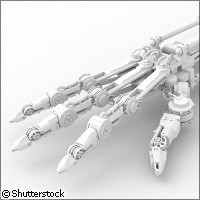Scientists control 'chaos' in robot behaviour
German scientists have developed a simpler way for an autonomous robot to perform a variety of tasks. The six-legged robot mimics human and animal behaviour and can now perform the same task with less effort and more flexibility. Published in the journal Nature Physics, the results of the study are part of the EU-funded PACO-PLUS ('Perception, action and cognition through learning of object-action complexes') project, which received almost EUR 7 million under the 'Information society technologies' Thematic area of the Sixth Framework Programme (FP6). For people and animals, small neural circuits known as central pattern generators (CPGs) control certain abilities, such as walking and breathing. Scientists use this principle to develop walking robots, with one CPG generally needed for each gait (i.e. manner of walking or moving). Information on the surrounding environment is typically delivered to a robot via sensors. The information it receives may, for instance, relate to an obstacle in its path or an impending ascent, and it selects the CPG controlling the gait accordingly. The team members, from various institutes in the German cities of Göttingen and Hanover, have developed a way for their robot to conduct the same task using one CPG that can produce a range of different gaits and can even switch between them. More specifically, the device allows 18 sensors to drive 18 motors, which can generate 11 basic behavioural patterns (e.g. orienting, taxis and self-protection) as well as their combinations. In their paper, the scientists explain that the control signal quickly and reversibly adapts to new situations and also accommodates learning and long-term storage of useful behavioural motor responses. 'Thus, such neural control provides a powerful yet simple way to self-organise versatile behaviours in autonomous agents with many degrees of freedom,' they said. The CPG developed by the team is a small network made up of two circuit elements, with 'chaos control' being the secret to its success. If the CPG is uncontrolled, the activity pattern is chaotic. This activity can, however, be controlled via the sensor inputs into periodic patterns that decide on the right gait. Different patterns, and therefore gaits, can be generated depending on the sensory input signal. As a result, the robot can adapt to changes quickly, such as walking up and down a hill and over rough texture, and at the same time avoid obstacles in its path. Since the neural circuit functions chaotically, the robot is also able to free itself should it become trapped in a hole, for instance. Furthermore, if the robot were to perform the same task a second time, it would immediately adopt the appropriate gait by recalling the original experience. In the future, the scientists plan on equipping the robot with a memory device that will improve its ability to respond to changes in its learned environment. For example, if the obstacle in an earlier experience were removed, the robot would no longer know which gait to use. Dr Marc Timme of the Max Planck Institute for Dynamics and Self-Organization in Göttingen explained that when the robot is eventually fitted with a motor memory it will be able to use foresight and plan its movements.
Countries
Germany



